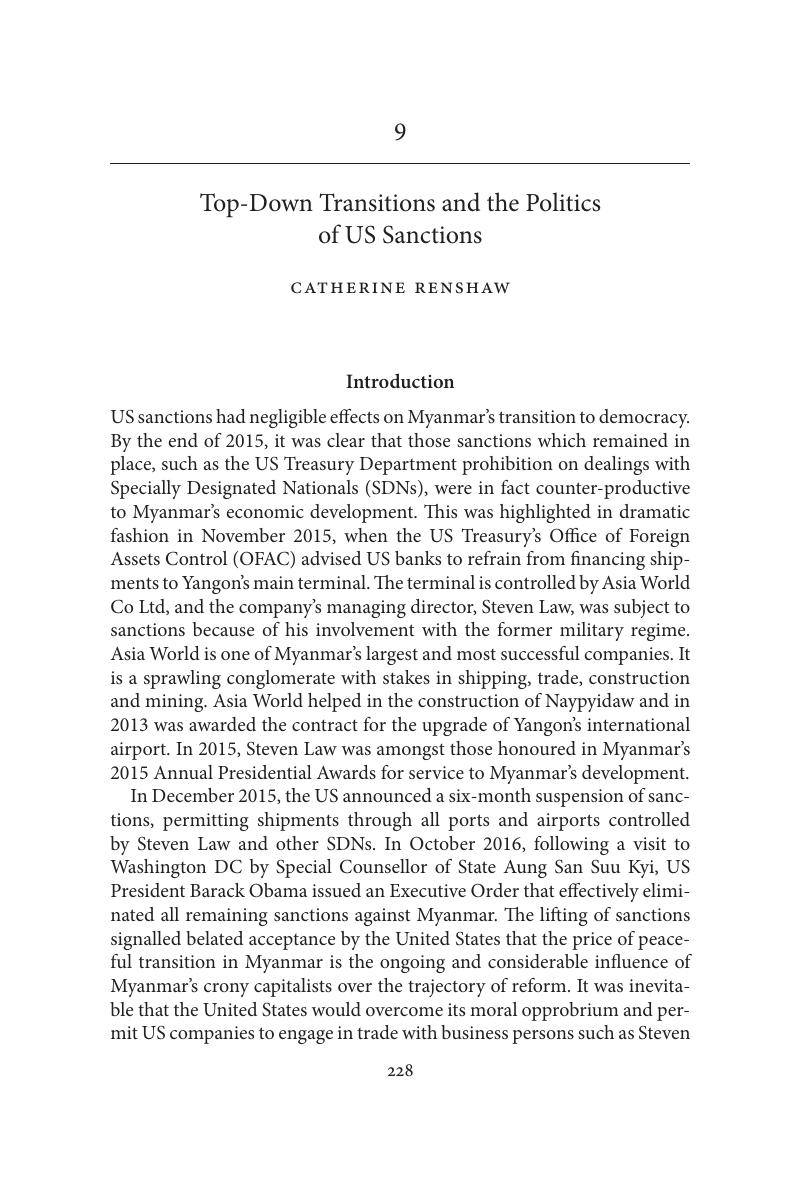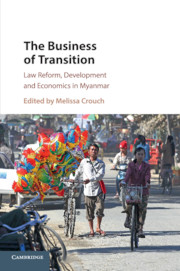Book contents
- The Business of Transition
- Advance Praise for The Business of Transition
- The Business of Transition
- Copyright page
- Contents
- Figure and Tables
- Contributors
- Foreword
- Acknowledgements
- Acronyms
- 1 Understanding the Business of Transition in Myanmar
- 2 Labour Standards and International Investment in Myanmar
- 3 The Extractive Industries Transparency Initiative
- 4 The Risky Business of Transformation
- 5 Microfinance in Myanmar
- 6 The Governance of Local Businesses in Myanmar
- 7 Special Economic Zones
- 8 Facing the Concentrated Burden of Development
- 9 Top-Down Transitions and the Politics of US Sanctions
- 10 The Politics of Aid in Myanmar
- Index
- References
9 - Top-Down Transitions and the Politics of US Sanctions
Published online by Cambridge University Press: 23 October 2017
- The Business of Transition
- Advance Praise for The Business of Transition
- The Business of Transition
- Copyright page
- Contents
- Figure and Tables
- Contributors
- Foreword
- Acknowledgements
- Acronyms
- 1 Understanding the Business of Transition in Myanmar
- 2 Labour Standards and International Investment in Myanmar
- 3 The Extractive Industries Transparency Initiative
- 4 The Risky Business of Transformation
- 5 Microfinance in Myanmar
- 6 The Governance of Local Businesses in Myanmar
- 7 Special Economic Zones
- 8 Facing the Concentrated Burden of Development
- 9 Top-Down Transitions and the Politics of US Sanctions
- 10 The Politics of Aid in Myanmar
- Index
- References
Summary

- Type
- Chapter
- Information
- The Business of TransitionLaw Reform, Development and Economics in Myanmar, pp. 198 - 227Publisher: Cambridge University PressPrint publication year: 2017
References
References
Burmese Freedom and Democracy Act of 2003 (Public Law 108–161; 50 U.S.C. 1701 note).
Customs and Trade Act of 1990.
Foreign Operations, Export Financing, and Related Programs Appropriations Act of 1997 (Public Law 104–208).
International Emergency Economic Powers Act of 1997 (IEEPA) (Public Law 95–223; 50 U.S.C. 1701 et seq.).
National Emergencies Act (NEA) (Public Law 94–412; 50 U.S.C. 1601 et seq.).
Tom Lantos Block Burmese Junta’s Anti-Democratic Efforts (JADE) Act of 2008 (JADE Act) (Public Law 110–286; 50 U.S.C. 1701 note).
Laws (US)
Burmese Freedom and Democracy Act of 2003 (Public Law 108–161; 50 U.S.C. 1701 note).
Customs and Trade Act of 1990.
Foreign Operations, Export Financing, and Related Programs Appropriations Act of 1997 (Public Law 104–208).
International Emergency Economic Powers Act of 1997 (IEEPA) (Public Law 95–223; 50 U.S.C. 1701 et seq.).
National Emergencies Act (NEA) (Public Law 94–412; 50 U.S.C. 1601 et seq.).
Tom Lantos Block Burmese Junta’s Anti-Democratic Efforts (JADE) Act of 2008 (JADE Act) (Public Law 110–286; 50 U.S.C. 1701 note).



